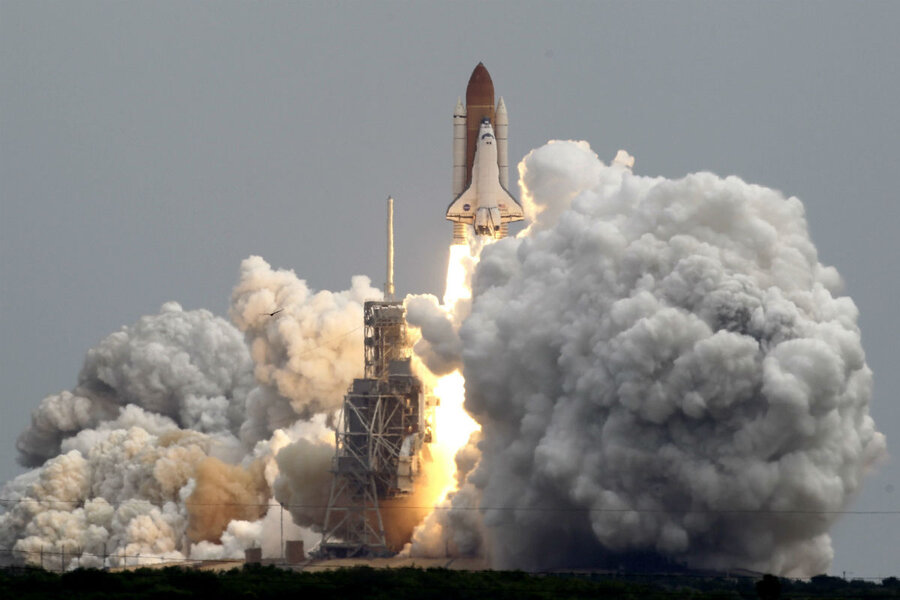SpaceX launch on Apollo 11 pad: Private spaceflight takes reins from government
Loading...
Sunday may be one mostly routine launch for a private space company, but one symbolic leap for the US government.
What was once possible for only the world’s most powerful states is becoming a standard assignment for private companies. SpaceX hopes to launch its tenth bag of goodies to the International Space Station on Sunday, ushering in a new era for the launch pad that first sent humans to the moon.
Originally scheduled for Saturday, the launch was postponed to allow time to investigate the cause of a hydraulic piston’s odd behavior. If all goes according to plan, Sunday’s flight will deliver 11,000 pounds of supplies and experiments to the ISS, including a light sensor for studying global lightning patterns and mice that may reveal how injuries heal in microgravity. SpaceX intends to land the reusable first stage rocket on a nearby landing pad, rather than the usual drone barge.
But this elaborate song and dance is quickly becoming the norm for SpaceX, which pulled off its historic first soft landing of a booster just over a year ago. Now, reusable rockets are piling up in its warehouses, and Sunday’s mission will be company’s tenth ISS rendezvous.
What makes this launch special is the milestone it represents for an often underappreciated component of spaceflight – the launch pad. Pad 39A served as the origin for a number of aeronautical landmarks, from the first lunar landing to early space shuttle flights.
Its next launch will mark its first action since the last shuttle flight more than half a decade ago.
"I'm a little partial to this pad, as all four of my shuttle flights lifted off from here," Bob Cabana, a former NASA astronaut and current director of NASA's Kennedy Space Center, said during a news conference at the pad on Friday. "So, it means a lot to see it in use and not wasting away in the salt air."
The pad’s rebirth also underscores a renaissance in the space industry, as it undergoes a sea change from public to largely private enterprise. This piece of infrastructure, which once cost US taxpayers over $100,000 a month to keep from rusting “to the ground,” has a metaphorical new lease on life thanks to a literal lease with SpaceX for the next 20 years.
Beating out competitor Blue Origin, SpaceX took over all operations and maintenance of the launch pad in 2015, starting with an extensive renovation that involved the removal of over 500,000 pounds of steel.
Meanwhile, NASA maintains control of the neighboring pad 39B, from which it hopes to launch future deep space missions with the next generation Space Launch System, currently under development.
This marriage of public and private signals the rapid emergence of a burgeoning new sector of the economy. In 2014, private activity accounted for just over three-quarters of the international space industry. SpaceX receives the lion’s share of the press, but dozens of companies now have launch capabilities, including Orbital Sciences Corporation, Blue Origin, and Virgin Galactic.
Many see this flurry of activity as just the beginning. "Most new space companies (there have been dozens) are not up to the challenge" of spaceflight and will disappear, writes space policy expert Howard McCurdy of American University in an email to The Christian Science Monitor.
"Yet if transportation history repeats itself, a few will emerge as dominant providers and become engines of economic growth," he says.
The US government has a long history of spurring transportation innovation, from financial support of the transcontinental railroad to the research contributions NASA forerunner NACA made to aeronautics during World War II. According to Dr. McCurdy, the space revolution will be no different.
“The government – NASA really – is supporting this movement in a number of ways. It is subsidizing the design of new spacecraft, promising to buy services, providing launch facilities, facilitating licenses and regulations, and helping with insurance issues. State and local governments are competing for spaceports and providing tax breaks,” he explains.
According to McCurdy, the difference between federal and commercial efforts comes down to risk aversion: “When government agencies take on new tasks, they cannot afford to fail. In private markets, economic failure is the engine of progress.”
The trick will be balancing the private sector’s tolerance for risk with the public’s need for safety, as SpaceX and Boeing draw closer to the first launches of their crewed capsules.
"What you get is an alternative discussion led by people who stand to make a profit," Mike Griffin, NASA administrator from 2005 to 2009, told Time in 2010. "Lockheed and Boeing say NASA's goals are too strict. Well, that's fine – up until the first accident, when people say, 'Where were NASA's standards?'”
But observers who are concerned that private industry’s yen for quick profits will overwhelm more cautious instincts may take heart in Saturday’s scrubbed SpaceX launch, after which CEO Elon Musk took to Twitter to espouse a "better safe than sorry" philosophy:








